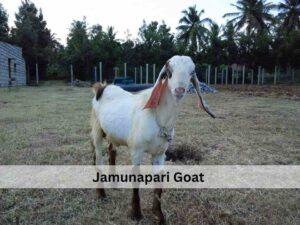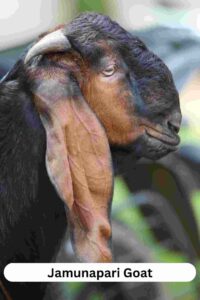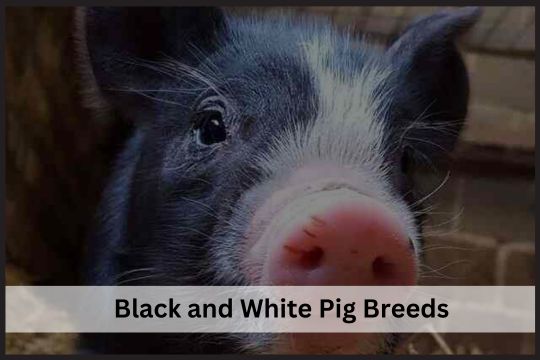Jamunapari goat is a beautiful pure goat breed of India and is also known by the name of ‘Ram Sagol’ and ‘Jamanapari’. Because of its majestic appearance, it is commonly known as ‘Pari’ in the area of its origin. This is supposed to have originated from the Indian subcontinent and also found in Bangladesh. The name of this goat is derived from the name of river Jamuna of Uttar Pradesh. Thus it originated from Etawah district of Uttar Pradesh. It is also found in Tamil Nadu, Maharashtra, Gujarat and Madhya Pradesh. This goat has been brought to Indonesia since 1953. This breed has been successfully raised in Indonesia since then.

Jamunapari goat breed is gaining popularity throughout the world due to their fast growth rate, higher milk yield, and excellent reproductive efficiency. The other things that are making them popular is their suitability to almost any kind of climate and less disease incidence than other goat breeds.
It is raised for both milk and meat i.e. it is a dual purpose breed. However, it is mainly raised for dairy purposes. This breed has been also used to create other breeds. American Nubian goats originated from Jamunapari goats.
| Name | Jamunapari Goat |
| Other Names | Ram Sagol, Jamanapari |
| Origin | UP, India |
| Breed Type | Dual Purpose Breed (Milk + Meat) |
| Temperament | Docile, Quick Learners |
| Breed Size | Large |
| Height | 80 cm (Male) And 75 cm (Female) |
| Weight | 65 to 85 kg (Buck) And 45 to 60 kg (Does) |
| Milk Production Per Day | 2.25 kg To 2.7 kg |
| Lactation Period | 250 Days |
| Lifespan | 10-12 years |
| Climate | Agro-Climate |
| Colours | White Coat Color With Small Tan Patches On Head And Neck |
| Alternative Breeds | Damascus Goat, Toggenburg Goat, Pashmina Goat |
Commercial Jamunapari Goat Farming
If you are planning for commercial goat farming, you have to consider the following things:
- At first prepare the business plan including initial investment, cost of housing, vaccination schedules, feeding cost and feeding plan. Also you have to prepare a marketing strategy before starting the business.
- Then you have to search for the nearest seller that sells the pure breed of this goat.
- Always choose the disease free goat. For this you have to consult with the veterinary doctors.
- Your farm should be thoroughly disinfected before getting goats to your farm.
- You can raise the Jamunapari goat under stall fed, semi-stall fed or open grazing conditions.
- Green fodder crops like Lucerne, maize, subabul can be grown in farm premises to reduce the feeding cost.
- If the goats are raised for milk purposes, you have to make a good plan for marketing the milk.
- There should be the good provision of timely vaccination and isolation room for isolating the suspected animal.
- Proper feeding is crucial for profitable farming. There should be a good provision of balanced nutritious feed.
- Farm houses should have all essential equipment and make sure that they are thoroughly sterilized before using.
Breed Characteristics

Breed characteristics are important for the identification of breed. Following are the characteristics of Jamunapari goat:
- This breed is large and tall. It is characterized with the long, flat, drooping ears and prominent Roman nose.
- Both male and female goats are horned. The horns of this goat breed are short and flat which are curved backwards.
- It has a short and thin tail.
- This goat breed has long hairs in the thigh and back legs.
- Coat color is variable. White coat color with small tan patches on head and neck is the most common.
- Slightly brown spots in their mouth and neck.
- There are long and thick hairs on their hind quarters.
- It has well developed udder with large conical teats.
- Age of sexual maturity of male varies from 9 to 12 months.
- Males are generally bigger than female goats. The average weight of adult bucks is 65 to 85 kg whereas that of does is 45 to 60 kg. The body length of male is about 80 cm and that of females is 75 cm.
- This breed of goat breed throughout the year.
- Average age at first conception is 1.5 years.
Breeding Behavior
Jamunapari goat breed has a high kidding ability. Triplets and quadruplets are common in this breed. This is also one of the reasons behind its popularity. This higher kidding percentage has helped the farmer to multiply their goat within a short duration. Also, this breed has a higher conception rate. Studies have shown that the conception rate is near to 90% and first kidding occurs at the age of 23 months. The twinning percentage was found to be 52%. This breed can reproduce throughout the year. However, the peak breeding season is May-June.
Management/Housing System
This goat breed is raised under an extensive housing system as they browse for 7-12 hours in a single day and stay in the house only at night. Some traditional farmers also raise their goats with other animals due to lack of space but for commercial profitable farming, good housing with supply of clean water is essential. A room equivalent to the area of 12*10 square feet can accommodate about 16 to 17 goats. The floor of the house should be at a certain height from the ground surface. Houses can be made from locally available materials like wooden, bamboo or concrete poles. There must be good provision of ventilation for facilitating air movement. The floor of the house should always be kept dry and clean. There should be the provision of separate houses for bucks which are used for breeding purposes. Also there must be the provision of an isolation room in the house for separating the diseased animal.
Feeding
They browse vigorously during winter and gradually slow down during the summer seasons. This goat spent about 80% of their time in grazing during winter whereas this falls to 50% during summer. They are browsers and they generally browse on bushes, small plants, leaves of trees and the top of grasses. They can be fed with a concentrated grain mixture. Pregnant goats should be provided with a special diet. You can feed them with barley, jowar, bajra and wheat. Wheat grain can be fed as whole or in the form of gruel. Up to three months of age kids are raised with their mother. During this time they consume their mother’s milk as well as green grasses and leaves. The male goat for breeding purposes should be supplied with the food enriched with sufficient protein, calcium and energy.
Milk production
This goat is popular for its higher milking ability than other indigenous goats. The average daily milk yield was found to be 2.25 kg to 2.7 kg. Fat composition of milk is about 5 %. The lactation period is about 250 days. The total milk yield in the lactation period of 250 days varies from 250-300 kg.
Meat Production
Beside its popularity for milk Production jamunapari goat is considered excellent for meat production. This breed has high quality meat that has high value in the market.
Growth Rate
This goat breed has excellent growth rates. The average growth rates of male and female kids were 59.4 and 48.2 g/day. The newborn kid of this goat was found to be 3 kg. Within one year, this breed becomes 21 kg.
Advantages
- Since Jamunapari is a hardy animal, disease incidence is less that lowers the cost of health management.
- It is a dual purpose goat and it is an excellent milk yielder.
- It is a beautiful breed and hence also suitable for showy purposes.
- Goat milk can be used for making various foods.
- It is adapted to almost all types of climatic conditions.
Is Jamunapari Goat Farming Profitable?
Jamunapari goat farming is highly profitable. The higher twining and milk producing ability has made it a profitable business. Besides, it is also a hardy breed and hence lower incidence of diseases that lowers the cost of cultivation.
Price (USA Price)
Generally, The price of Jamunapari Goat in USA is 200$ – 500$.
Conclusion
Jamunapari goat is a beautiful goat breed that is native to India. It is characterized by a prominent Roman nose and long pendulous drooping ears. You can make a decent profit from Jamunapari goat farming. The prerequisite for this is proper business plan and marketing strategy. As it is a dual purpose breed, it is excellent for commercial farming. Also, this breed has higher milking ability, higher kidding percentage and is adapted to almost all types of climatic conditions. Similarly, this breed can be raised under stall feeding, semi-stall feeding or open grazing conditions in an extensive housing system as this breed spends 7-12 hours a day in browsing.

